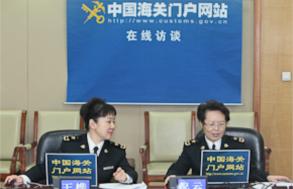 Online Interview
Online Interview
Topic: The Past & the Present of China Customs – about a Close Look into China Customs Museum
Time:10:00 AM (Thu) March 27, 2014
Special Guests: Ni Yun, Curator of China Customs Museum
The Past & the Present of China Customs – about a Close Look into China Customs Museum
[Wang Hua]: Hello, netizens, welcome to China Customs Online Interview! I'm Wang Hua. China Customs Museum is going to open this coming Sunday. To help our audience get a better understanding of the Museum, we are joined by Ms. Ni Yun, the first Curator of China Customs Museum, to share with us the past and the present stories of China Customs. Welcome, Ms. Ni! 03/27/2014 10:00:03
[Ni Yun]: Nice to see you, everyone! 03/27/2014 10:00:32
[Wang Hua]: Ms. Ni, would you please give us an overview of the Customs Museum first? 03/27/2014 10:01:14
[Ni Yun]: OK. China Customs Museum is a national industry-specific museum established upon the approval by the National Development and Reform Commission. The Museum is located at No. 2, Jianguomennei Street, Dongcheng District, Beijing, southwest to Jianguomen Bridge. It has an exhibition area approximating 8,600 square meters, that is, about the size of a football field. 03/27/2014 10:01:51
[Ni Yun]: So far, the China Customs Museum has taken shape, consisting of the Permanent Displays and three thematic displays, including the “Customs 902” boat and Customs Clearance Experience in the main exhibition area, as well as three temporary exhibition halls. 03/27/2014 10:02:17
[Ni Yun]: The Permanent Displays section, by presenting the evolution and development of Customs and their functions and responsibilities in ancient, modern and contemporary China in a systematic manner, shows the roles of Customs in national economic and social development in different periods since the set-up of the first customs office in the Western Zhou Dynasty and reveals the historical rule that “the Customs prosper and decline with the rise and fall of a country”. The Thematic Displays section, featuring three displays themed the “Customs 902” Vessel, Customs Clearance Experience and Customs IPR Enforcement, is an essential supplement to Permanent Displays. The temporary exhibition halls are intended for temporary theme-specific exhibitions in light of varied needs. 03/27/2014 10:02:46
[Wang Hua]: “The Customs prosper and decline with the rise and fall of a country.” Customs is a witness to the rises and falls of a nation! 03/27/2014 10:03:25
[Ni Yun]: Yeah. Customs, as a state authority supervising and controlling entry and exit affairs, is the “gateway” of a country’s opening-up and a symbol of national sovereignty, and is closely related to the fate of a country or nation. It's been more than 3,000 years since the establishment of military checkpoints with basic powers of a customs office in the Western Zhou Dynasty. Customs have witnessed the ups and downs of our country and been carrying the glories and dreams of Chinese people, especially in the late Qing Dynasty and the period of the Republic of China, when customs was reduced to semi-colonial customs office controlled by foreign inspector generals and commissioners. Customs sovereignty was not returned to the hands of China and its people until the founding of the People’s Republic of China. In some sense, the history of Customs is an epitome of the Chinese history. 03/27/2014 10:04:21
[Wang Hua]: Many people probably don’t know that Customs have such a long history. Now, Ms. Ni, please tell us something more about the history of Customs! 03/27/2014 10:05:13
[Ni Yun]: Chinese customs have a really long history. As early as the Western Zhou Dynasty, “passes (Guan in Chinese)” with military functions had already been set up, and border checkpoints “passes and ferry posts” established during the Spring and Autumn and the Warring States Periods (770-221 BCE) possessed some modern customs powers such as supervision, anti-smuggling and tax levy; during the Tang, Song, Yuan and Ming Dynasties (from about 618-1644 AD), “maritime trade offices” integrated multiple functions including customs, foreign trade administration and foreign affairs management; four customs offices were set up in Fujian, Guangdong, Jiangsu and Zhejiang Provinces in the early Qing Dynasty, and the term “customs” was officially introduced; after the First Opium War (1840 AD), China gradually lost its sovereignty over its duties, customs administration and custody of customs taxes, and customs offices were relegated to semi-colonial customs houses controlled by foreigners; in October 1949, the People’s Republic of China took back the keys to its gateways and finally reclaimed back its customs sovereignty. 03/27/2014 10:06:04
Quick Links







